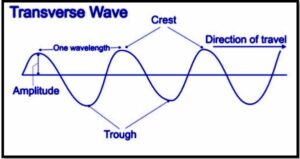Table of Contents
A transverse wave is a wave with oscillations that are transverse to the wave’s advanced direction in physics. A longitudinal wave, on the other hand, travels in the direction of its oscillations. Transverse waves differ from longitudinal waves in that the oscillations occur in the wave’s direction.
A Brief Outline
Because of the shear stress generated, transverse waves typically arise in elastic solids; the oscillations in this instance are the displacement of the solid particles far from their relaxed position in directions perpendicular to the wave propagation. These displacements correlate to the material’s local shear deformation. As an effect, a transverse wave of this type is stated as a shear wave.
Important Concepts
One way to categorize is by the direction of motion of the individual particles of the medium in relation to the wave propagation direction. On this premise, waves are divided into two distinct categories: transverse waves and longitudinal waves. A transverse wave is one in which the particles move perpendicular to the wave’s propagation direction. A longitudinal wave is one in which the particles move in a direction that is parallel to the propagation of the wave.
Inelastic solids, transverse waves are prevalent, and oscillations are the displacement of solid particles from their relaxed state in a direction perpendicular to the wave’s propagation. The transverse waves of this form are characterized as shear waves because these displacements correlate to the local shear deformation of the material. Shear waves are sometimes referred to as secondary waves or S-waves in seismology.

The Transverse Wave’s Speed
Peaks and troughs are found in transverse waves. The top of the wave is the peak, and the bottom of the wave is the trough.
The following are some instances of transverse waves:
- The ripples on the water’s surface
- Waves of electromagnetic energy
- A people wave or a stadium
- Waves of the sea
- An earthquake’s secondary waves
Significance of transverse waves in IIT JEE exam
The Oscillations and Waves chapter, which accounts for 10% of the exam questions, covers a wide range of topics. All you have to do is grasp the concepts of each topic. If you stick to this plan, your Physics preparation would be spot on, and you’ll be able to pass this section with flying colours. As per the distribution of levels of difficulty in the previous year’s tests, basic and medium-level questions make up roughly 83 percent of the JEE paper.
FAQs
Is light longitudinal or cross-over, and provided that this is true, how?
Since light has both electric and attractive energy parts, it is alluded to as an electromagnetic wave. All electromagnetic waves head down a similar path.
How do waves in a string shape?
These are cross-over waves in light of the fact that the particles of a string are obliged and venture out opposite to the wave bearing. There are pinnacles and boxes in these vibrations. Standing waves are shaped when various waves are created in a string.
What is the qualification between a longitudinal and a cross-over wave?
Waves with an unsettling influence that moves opposite to the wave's course are known as cross-over waves. Longitudinal waves are those wherein the aggravation moves in the same heading as the actual wave.



